Are you curious about starting a vegetable garden? Many people are now growing their own veggies at home. If you’re new to gardening, you might wonder where to begin.
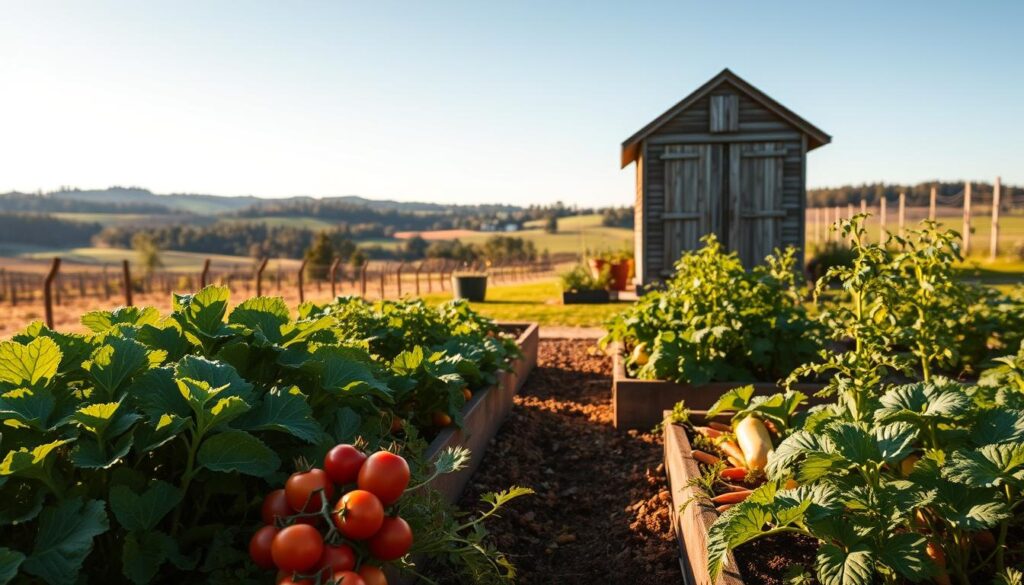
Getting Started with Vegetable Gardening
Vegetable gardening is a fulfilling hobby that lets you grow your own food. With a few easy tips, you can create a garden that will give you lots of fresh produce.
Key Takeaways
- Start small with a 6×6 feet garden and up to five types of vegetables
- Choose a location with at least 6 to 8 hours of direct sunlight daily
- Use a well-planned crop rotation to reduce pests and diseases
- Water regularly, especially during the first few weeks after planting
- Test your soil to determine its pH and nutrient levels
- Consider using container gardens or raised beds for easy maintenance
- Keep a garden journal to track your progress and plan for future seasons
Essential Tools and Materials for Your First Vegetable Garden
To start a successful vegetable garden, you’ll need the right tools and materials. A good vegetable garden planting guide helps you use your space well. When growing vegetables at home, you need tools for soil prep, planting, and garden care.
Here are the basic tools you’ll need to get started:
- Garden fork
- Shovel
- Watering can
- Hand trowel
- Garden gloves
These tools help with tasks like tilling, planting, and watering. You also need to prepare the soil, pick the right veggies, and ensure enough sunlight and water.
Good quality soil and compost are key for a healthy garden. Test your soil and fix it if needed. Raised beds or containers are good for small spaces or poor soil.
With the right tools and materials, you’re ready to create a thriving garden. Follow the steps to start a vegetable garden and enjoy watching your plants grow.
Choosing the Perfect Location for Your Garden
When planning your vegetable garden, picking the right spot is key. You need a place with lots of sunlight, good drainage, and near water. Most veggies need 8 hours of sunlight daily.
Leafy greens can do with 4-6 hours of sunlight. Root veggies need 6-8 hours. Think about the veggies you want to grow and pick a spot with enough sunlight. Also, make sure the soil is fertile and drains well. A good sign is if you see 10 or more earthworms in a small hole.
Here are some things to think about when picking the perfect spot for your garden:
- Proximity to a water source
- Level ground and protection from wind and water runoff
- Convenience and accessibility, close to paths or your house
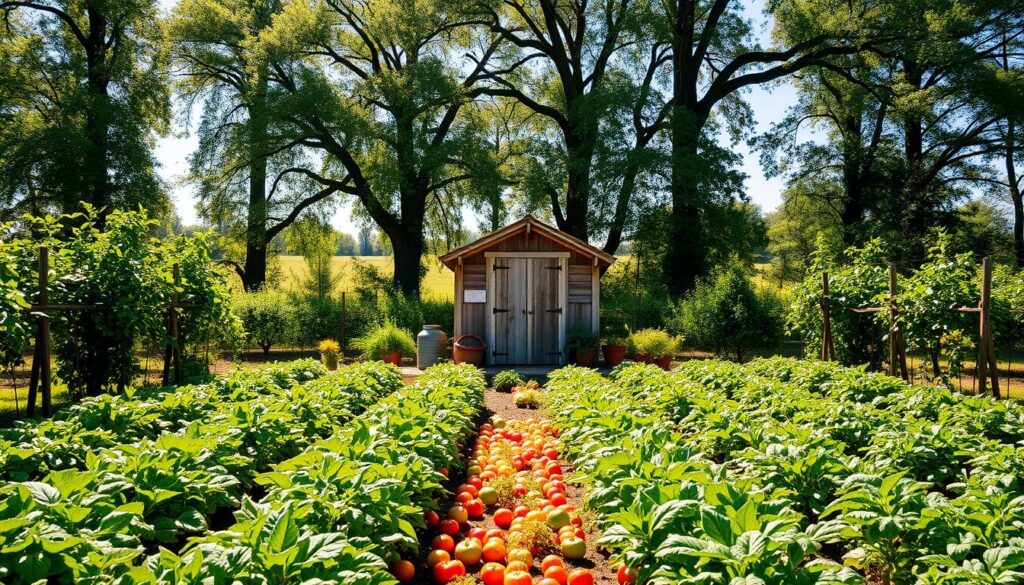
By considering these points and choosing wisely, you’ll have a great vegetable garden. It will give you fresh veggies for months. Make sure to check the spot and adjust if needed for the best growing conditions for your best vegetables for beginners.
Understanding Your Growing Zone and Season
For organic vegetable gardening, knowing your growing zone and season is key. As a beginner in vegetable gardening for beginners, it’s important to pick the right plants for your area. The USDA Plant Hardiness Zone Map helps by dividing North America into eleven zones based on temperature.
The USDA zones have “a” and “b” segments, showing a five-degree temperature difference. For example, Zone 4 has temperatures from -30 to -20 degrees Fahrenheit. Knowing this helps you figure out the best time to plant and harvest.
To find your growing zone, use the USDA Plant Hardiness Zone Map. A seasonal planting calendar can also help plan your garden. Checking the average last and first frost dates in your area is another way to plan. By understanding your growing zone and season, you can plan a successful organic vegetable gardening season.
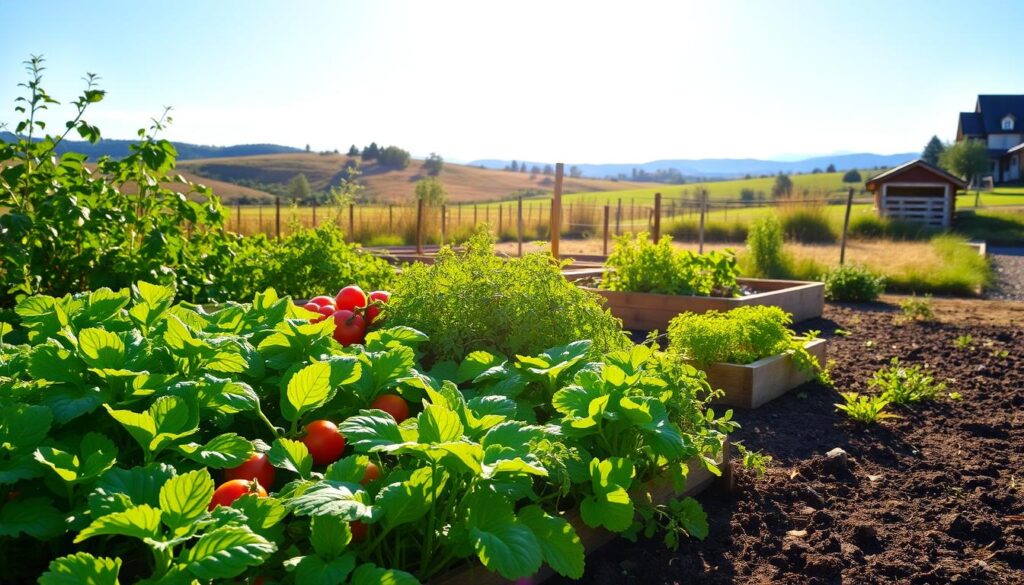
Here are some key factors to consider when planning your vegetable gardening for beginners:
- USDA Hardiness Zone: Determine your zone to know what plants are suitable for your area.
- Seasonal Planting Calendar: Plan your garden accordingly to ensure a successful harvest.
- First and Last Frost Dates: Check the average dates in your area to determine the growing season.
How Do I Plant a Vegetable Garden: Step-by-Step Process
Planting a vegetable garden starts with choosing the right spot. It should get at least six hours of sunlight a day. Then, add a 2- to 4-inch layer of organic mulch to keep weeds away and improve soil.
Beginners should start with a 4-foot-by-4-foot raised bed. This size makes it easier to manage your plants. Make sure to space them 2 to 3 feet apart to prevent overcrowding and diseases.
Start with easy crops like carrots, beans, cucumbers, peppers, and lettuce. Tomatoes, peppers, and cucumbers do well in warmer weather. Plant them after the last frost. Lettuce, spinach, and broccoli prefer cooler weather, so fall is a good time to plant them in warmer areas.
Remember these important steps:
- Test your soil’s acidity and add supplements if needed
- Compost annually to keep the soil healthy
- Water plants two to three times a week, or more in summer
- Harvest vegetables when they’re young and tender
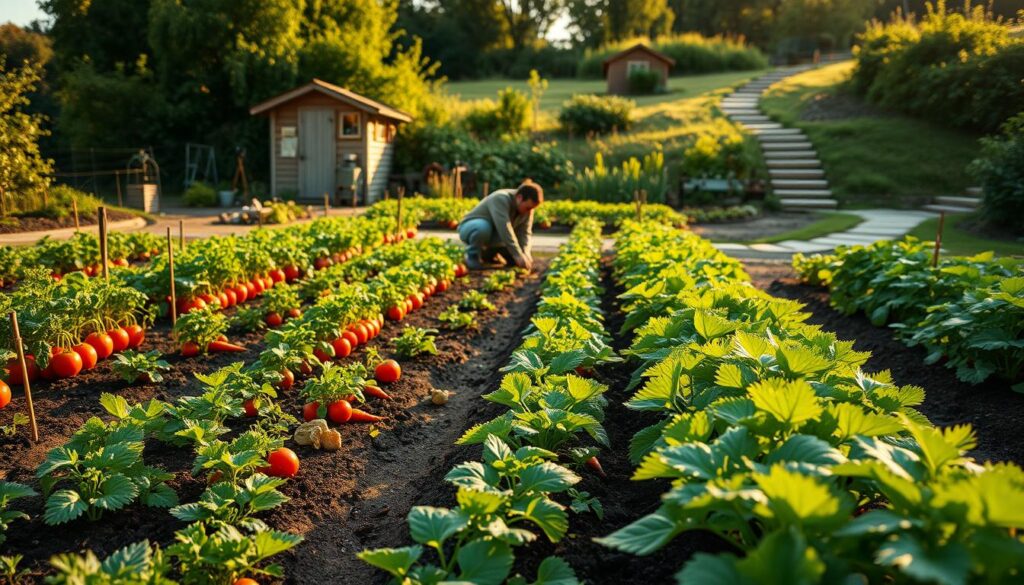
By following these steps, you can grow a successful vegetable garden. It will give you fresh produce for months.
Soil Preparation and Amendment Techniques
Preparing the soil is key in vegetable garden planning. It involves testing the soil, adding organic matter, and ensuring proper drainage. This creates a perfect environment for your plants to flourish, which is vital for organic vegetable gardening.
First, test your soil quality. You can send a sample to a lab or use a DIY kit. The results will show your soil’s pH level, nutrient content, and organic matter. Then, you can add the right amendments to make the soil more fertile.
Adding compost or manure is a great way to enrich your soil. A 2-3 inch layer of compost worked into the soil a month before planting can greatly help. Also, make sure to have good drainage to avoid waterlogged soil, which harms plant growth.
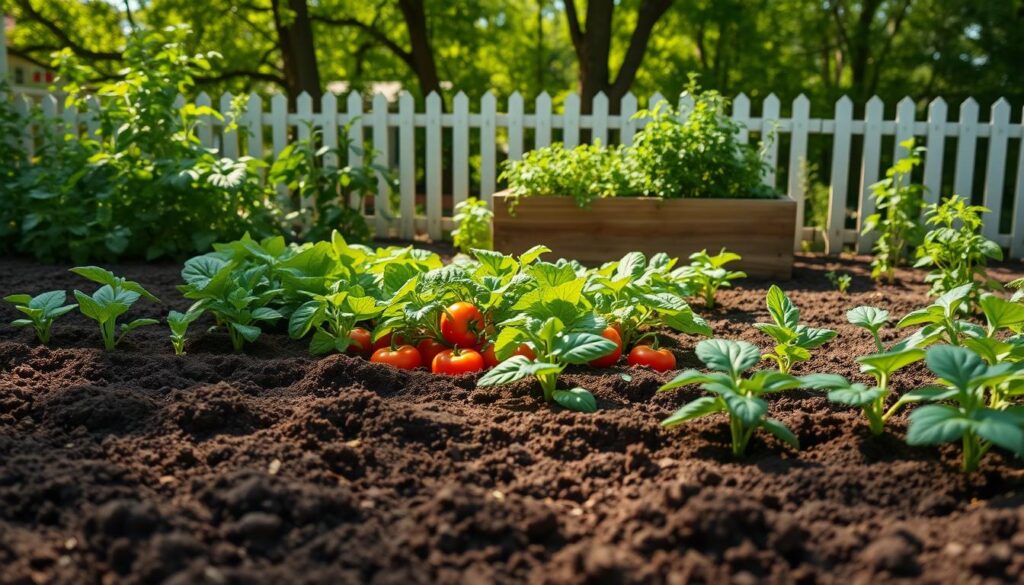
- Test your soil quality to determine its pH level and nutrient content
- Add organic matter such as compost or manure to improve soil fertility
- Implement proper drainage solutions to prevent waterlogged soil
By following these steps, you can make your vegetable garden planning and organic vegetable gardening successful. You’ll have a thriving and productive garden.
Selecting the Best Vegetables for Beginners
Choosing the right vegetables is key for vegetable gardening for beginners. You should pick varieties that are easy to grow and need little care. Lettuce, green beans, radishes, and tomatoes are great for beginners. They are easy to grow and don’t get many pests or diseases.
Think about your climate and growing conditions when picking vegetables. If your growing season is short, choose quick-growing ones like lettuce or radishes. For longer seasons, tomatoes or cucumbers are good choices. This way, you can make your vegetable gardening for beginners a success.
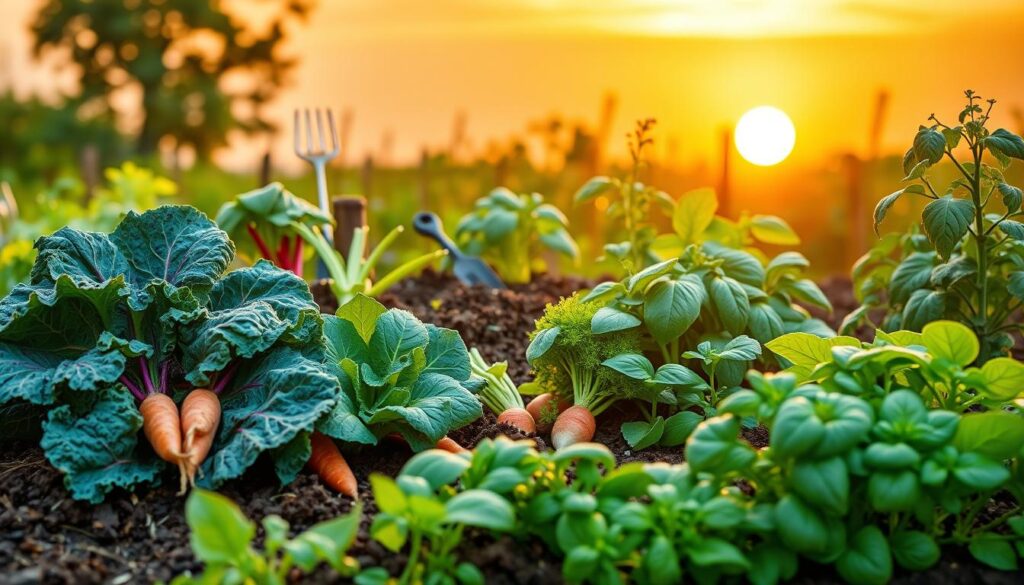
Consider your garden’s space, sunlight, and soil type when picking vegetables. This helps you create a garden that’s both productive and easy to care for. Whether you’re starting or expanding your garden, picking the right vegetables is crucial.
Here are some popular best vegetables for beginners to consider:
- Lettuce and other leafy greens
- Green beans and other legumes
- Radishes and other root vegetables
- Tomatoes and other fruiting vegetables
Start with these easy vegetables to build your gardening skills. Then, you can try more challenging ones as you get better.
Proper Planting Techniques and Spacing
When growing vegetables at home, it’s key to use the right planting techniques and spacing. This ensures healthy growth and avoids overcrowding. Tips often stress the need for enough space for air and root growth. For example, Brussels sprouts and squash need more room because of their size and growth.
It’s important to follow specific spacing guidelines for each vegetable. Here are some general tips:
- Leafy greens like lettuce and kale can be planted closely together, about 1-3 inches apart.
- Root vegetables like carrots and beets require more space, about 2-4 inches apart.
- Vining plants like cucumbers and tomatoes need to be spaced about 24-36 inches apart to allow for proper growth and air circulation.
By following these tips and providing enough space, you can create a thriving garden. This will give you fresh produce for months. Always check the specific spacing needs for each vegetable you grow for the best results.
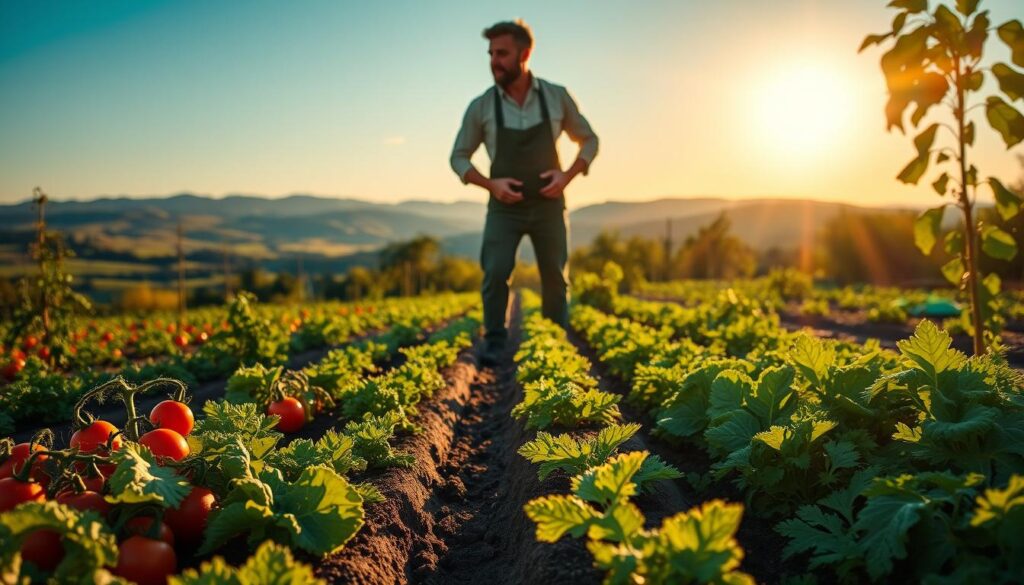
With the right planting and spacing, you’ll have a successful vegetable garden at home.
| Vegetable | Spacing Between Plants | Spacing Between Rows |
|---|---|---|
| Tomatoes | 24-36 inches | 48-60 inches |
| Cucumbers | 8-10 inches | 60 inches |
| Carrots | 1-2 inches | 12-18 inches |
Watering and Irrigation Systems
Watering is key in vegetable garden planning. It’s vital for healthy growth and saving water. Organic gardens need efficient irrigation to save water and cut down on waste.
There are many irrigation systems out there. Overhead watering works well in dry places. But drip irrigation and soaker hoses save more water. Drip irrigation is the best because it waters the soil directly, cutting down on evaporation.
Here are some tips for watering your garden:
- Water in the morning to avoid losing water to evaporation.
- Check the soil moisture daily or every other day. Water when the top inch is dry.
- Use mulch to keep the soil moist and prevent water loss.
- Choose plants that don’t need much water to save on water use.
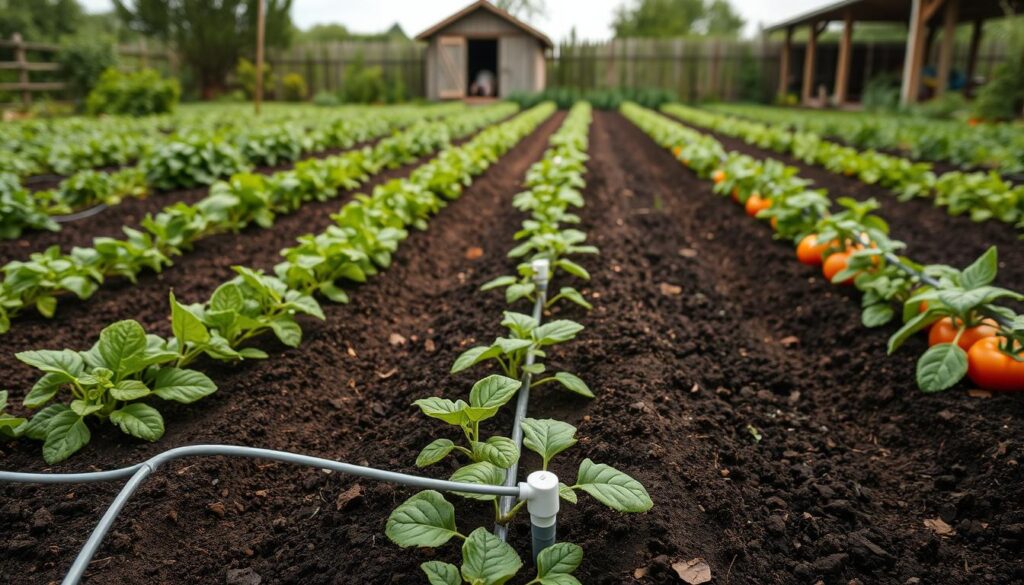
In organic gardening, using efficient irrigation is crucial. Follow these tips and pick the right system. This way, you’ll have a garden that’s full of life and gives you fresh food all year.
Natural Pest Control and Disease Prevention
Starting your organic vegetable gardening journey means learning about natural pest control and disease prevention. These methods protect your plants and help the environment. For vegetable gardening for beginners, knowing about these is key for a successful garden.
Common pests include aphids, whiteflies, and nematodes. To fight them, try neem oil, diatomaceous earth, and insecticidal soap. Crop rotation, companion planting, and the right watering also prevent diseases.
Preventing disease is also important. Remove sick plants and use biofungicides. These steps help keep your organic vegetable gardening space healthy. It’s great for vegetable gardening for beginners.
Here are some important tips for natural pest control and disease prevention:
- Use natural products like neem oil and diatomaceous earth
- Try crop rotation and companion planting
- Water your plants correctly
- Remove sick plants and use biofungicides
Garden Maintenance Throughout the Growing Season
Keeping your vegetable garden in top shape is key for a great harvest. Follow some gardening tips and watch out for pests and diseases. Start by adding a 2-3 inch layer of organic mulch around your plants. This will help fight weeds and keep the soil moist, saving you from too much watering.
Watering right is important – aim for 1 inch of water per week. This can come from rain or you watering it. Container plants might need more water, especially when it’s hot and dry. Also, using biostimulants and microbial inoculants can boost soil and plant health. A balanced, slow-release fertilizer like Miracle-Gro® Shake ‘n Feed® can feed your plants for up to 3 months.
By following these vegetable gardening tips, you’ll have a thriving garden. You’ll enjoy the fresh, homegrown food you’ve grown yourself!
FAQ
What are the essential tools and materials I need to start a vegetable garden?
You’ll need a garden fork, shovel, and watering can. Also, get high-quality soil, compost, and containers or raised bed materials.
How do I choose the perfect location for my vegetable garden?
Look for a spot with lots of sunlight and good drainage. It should get at least 6 hours of direct sunlight a day.
How do I understand my growing zone and season?
Know your USDA Hardiness Zone and frost dates. Use a seasonal planting calendar to plan your garden.
What are the steps to actually plant a vegetable garden?
First, prepare the soil. Then, pick the right vegetables and plant them correctly. Don’t forget to water and fertilize them.
How do I prepare the soil for my vegetable garden?
Test your soil and add compost. Make sure it drains well for the best growing conditions.
What are the best vegetables for beginners to grow?
Start with lettuce, tomatoes, cucumbers, carrots, and herbs. Pick varieties that fit your climate and growing conditions.
How do I properly plant and space my vegetables?
Use the right planting methods and space them correctly. Companion planting can also help your garden grow well.
How do I water and irrigate my vegetable garden?
Water deeply but not too often. Consider drip irrigation to save water. Mulching helps keep moisture in.
How do I naturally control pests and prevent diseases in my garden?
Use organic pest control like neem oil. Prevent problems with crop rotation and companion planting.
How do I maintain my vegetable garden throughout the growing season?
Keep up with watering, fertilizing, pruning, and pest checks. Regular care leads to a great harvest.

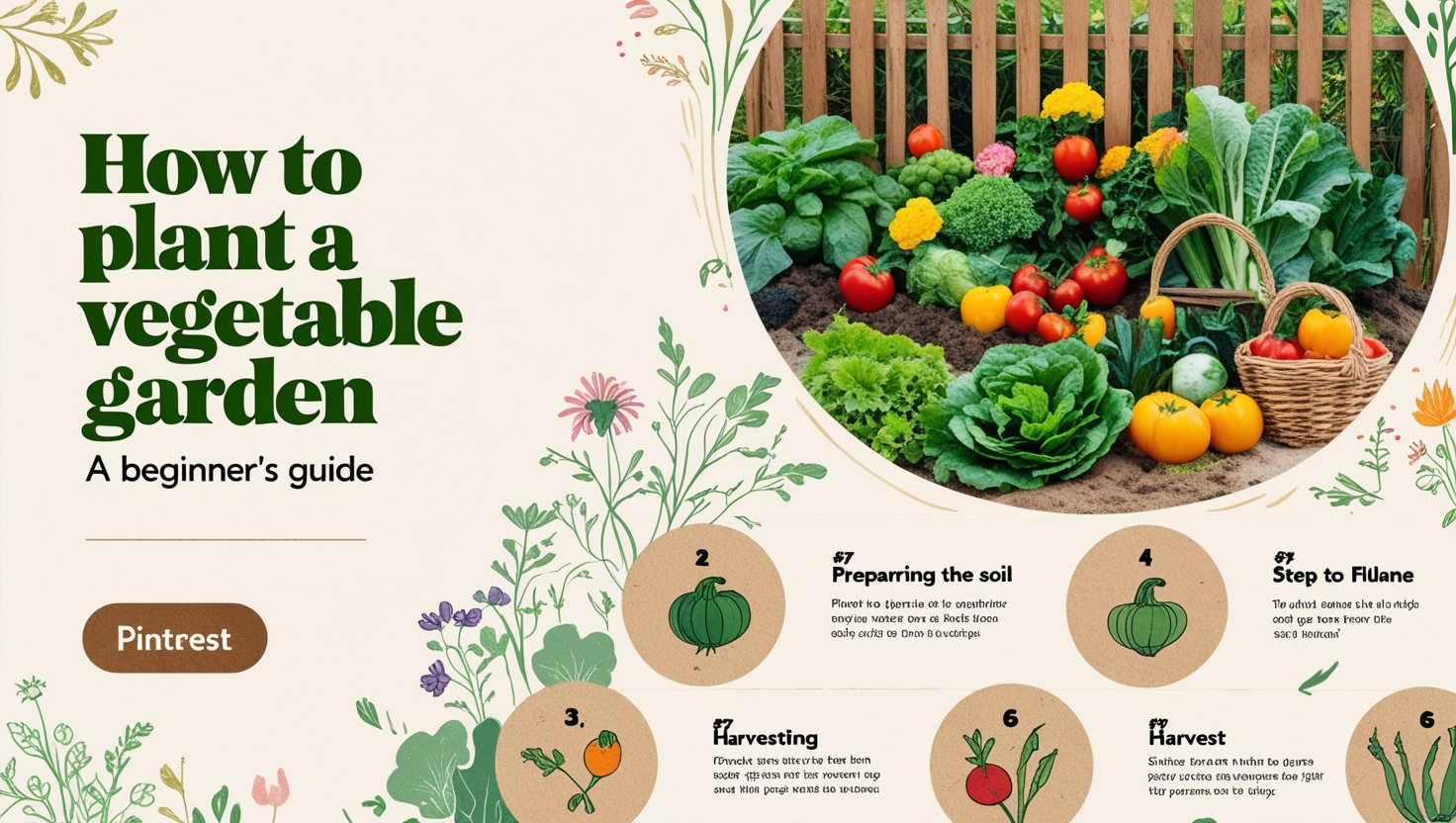
1 thought on “How to Plant a Vegetable Garden: A Beginner’s Guide”